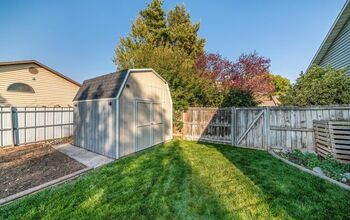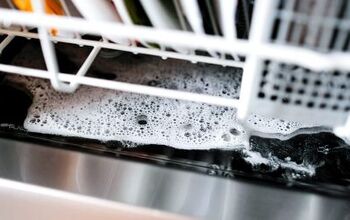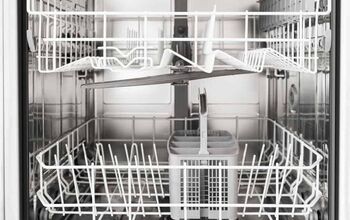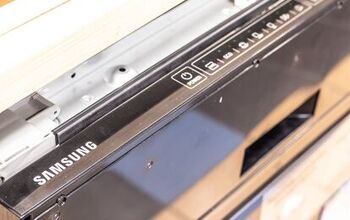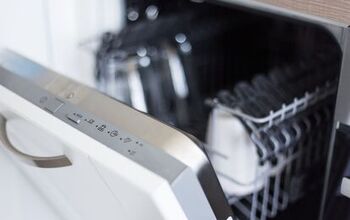Water In The Bottom of Dishwasher When Off? (Try This Fix!)

Is your dishwasher not draining properly? Too much water in your dishwasher’s bottom could be a sign that something is wrong. Luckily, you can fix it with a few easy steps.
Inspect the drain hose for debris and clogs, and make sure that it doesn’t hang too low. Use a zip tie to secure the drain hose in place so it doesn’t sag, and clear any clog with a brush or wire. Clean and shut your inlet valve, and make sure that the float assembly is clear.
It can be discouraging when something is wrong with one of your appliances, and you can’t seem to figure it out. Standing water at the bottom of a dishwasher can be caused by more than one thing, but most of them are easy to fix.
Let’s take a look at how to troubleshoot your dishwasher, and what to do to fix it, depending on your issue. Most of these problems can be solved without calling in a plumber.
Do You Need Appliance Repair Services?
Get free, zero-commitment quotes from pro contractors near you.

Should Water be Left in the Bottom of my Dishwasher?
After you run your dishwasher, you may have noticed that there is water left in the bottom of the unit. In most cases, this is perfectly normal. It helps to keep the seals from drying up after using it. However, over time, the water should completely drain.
Standing water after a few hours is a sign that something is not right. If you have ever opened up your dishwasher and been hit with the smell of old standing water, then you know how gross it can be. If the water does not drain, you are forced to run the machine with the stale water still inside.
This is not a good way to clean your dishes. You will need to drain the dishwasher, by scooping out the water, and then troubleshoot the dishwasher to find out what is causing the problem.
How to Troubleshoot Your Dishwasher Backing Up
The dishwasher could be backing up for several reasons. You will need to do a little bit of troubleshooting, to find out just what the problem is. You can start with the easiest fix first, this way, you may be able to avoid replacing parts or calling in a repairman.
Some common issues:
- The drain hose is clogged or obstructed
- The filter is clogged or dirty
- Float assembly is not working properly
- The Inlet valve is not working
The most common of these issues is the drain hose. The drain hose could be clogged, obstructed by a kink, or it is laying down low and flat. Start with the drain hose, and work your way through this list of issues.
Before working on your dishwasher, make sure that it is unplugged, or that the breaker is turned off. Also remove the standing water, using a cup, or bowl, to scoop out the water, until there is little to no water left.
The Drain Hose
The drain hose is the easiest fix and the most common of all the problems concerning standing water at the bottom of your dishwasher. A drain hose can cause this for multiple reasons.
The drain hose is too low and flat. All drain hoses are different. Some of them lay flat under the kitchen sink, and need to be lifted, to allow the water to drain properly. Having it low and flat, can cause the water to back up into the dishwasher. Use a zip tip to keep it raised.
Kinks the drain hose. The drain hose may have kinks in it. Inspect the hose, to see if there are kinks. If you find any, straighten the hose out and make sure no restrictions are causing it to kink up.
Clogged drain hose. Inspect your drain hose for any clogs. You may need to blow air through the hose or use a wire to push out the clog. Drain hoses that are attached to garbage disposals can become clogged easily. You can start by running your disposal to break up any clogs.
The Inlet Valve
Your water inlet valve may be stuck open, causing the water to back up into your dishwasher. This is usually caused by calcium deposits that build up over time. It happens in areas that have hard water. If the problem is with the inlet valve, then you will need to replace it.
Do not wait for it clear itself out, you could end up flooding your dishwasher and the floor. There is no way to clean the valve, so you will have to replace the entire piece. They are inexpensive and easy to replace.
The Float Assembly
The float assembly may not be working properly, and this could cause the water to build up at the bottom of the dishwasher. Remove the cap of the float assembly. Lift it, and drop it down, to make sure that it is moving freely.
Debris could be causing it to not fall back down into place, this can cause the cycle to stop before it has completely finished. Remove any debris that may be keeping it from falling into place.
Clean or Change the Filter
Another easy fix is cleaning or changing the filter. A lot of people do not seem to know that dishwasher filters need to be cleaned or replaced, regularly. They get dirty and the build-up can make it so that water will not pass through and drain properly.
Check your owner’s manual to find out where the filter is located. It will also tell you how often to clean it, and the proper way to clean it. If the filter has become too dirty, you may need to get a new one, check the manual for the replacement part number.
Most filters are found inside of the dishwasher at the bottom. Usually, you can remove them, and spray them with water. However, check your manual for the manufactures instructions on cleaning.
How to Drain a Dishwasher
Now that you have found that your dishwasher has standing water, you will need to remove the water. This can be done in a few different ways. You could start by running the machine with no dishes, this may cause a blockage to become unblocked.
If running the dishwasher does not let the water drain, then you will need to manually remove the water, by using a cup, or bowl. Place towels down on the floor underneath the dishwasher, in case you spill any water. You will want to have a bucket, to put the water into, or you could put it down the sink drain.
Remove the water until little, or no water is left. This will let you troubleshoot the dishwasher and find a fix.
Tips for Unclogging Drain Hose
Unclogging the drain hose can be tricky. There are a few methods that may work for you. You can start by removing the hose from one end and blowing into it. This could help unclog it, and it will let you know if something is clogging or obstructing the hose.
If this does not unclog the hose, you may have to use a wire of some sort, to push through the hose, being careful not to puncture it. If you have a garbage disposal, you can start by running it, sometimes this will help unclog the hose since it attaches to the pipes under the disposal.
Do You Need Appliance Repair Services?
Get free, zero-commitment quotes from pro contractors near you.

Related Questions
Can I run a dishwasher with standing water?
You can try running the dishwasher without any dishes, to try and unclog a hose, or break up any calcium deposits that are causing it not to drain. If you have stale water, we do not suggest running it with dishes, as it would be unsanitary.
How much water should be in the bottom of my dishwasher?
After you run the dishwasher there will be some water left in the bottom. The water should not go above the float assembly. It is natural to have some water, but too much water will mean that something is not working properly. Luckily most of the problems are easy to solve.

I'm a writer that is passionate about home improvements, remodeling, and renovating. I enjoy learning new skills and techniques and sharing them with others.
More by Chad Kilpatrick




